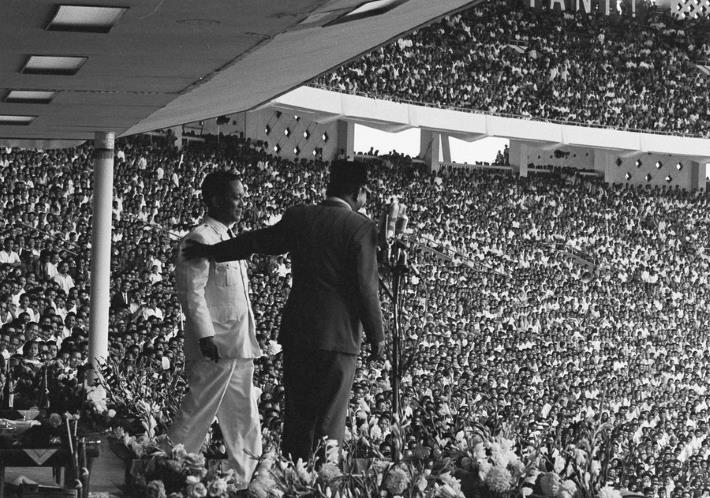For half a century, serious discussion of this shocking violence has been taboo within Indonesia. However, the taboo has begun to lift in recent years. This edition of Inside Indonesia asks: how do these events continue to impact Indonesia today? What does ‘1965’ mean to Indonesians? How do they continue to live with the massacres?
Clearly there is more than one answer to these questions. In 2015, many stories about the meaning of ‘1965’ compete with each other to be told. Some of these competing narratives are heard very loudly. Others are only whispered. The pain and bitterness will not begin to go away until we listen to them all.
This edition approaches these questions in three ways. First, we look at competing narratives in historical culture. Indonesian school history textbooks remain silent about the violence and suffering the victims of ‘1965’ experienced. The books just talk politics – regime change was necessary for political stability. But the silence is broken in many other places. Ayu Ratih writes from her own experience as a student growing up with just the narratives in the school books. Only when she personally met some of the ageing victims did she change her mind about them. She discovered they knew something she desperately wanted to know.
Alle Hoekema analyses six influential novels that discuss ‘1965’. They were written between the 1980s and the present day. He finds that they all sympathise with the communist victims of the killings. At the same time, they tend to regard the whole episode as a tragedy, for which justice is no longer possible.
The second approach is to examine institutional legacies and civil society. Official stories have often been challenged within civil society, yet they continue to permeate institutions within Indonesia. How can this be? Adriaan Bedner examines legal institutions and finds a surprising development. The repressive measures taken against survivors of the anti-communist persecution have now been all but lifted. The Supreme Court played an important role in this. But at the same time, the official ban on the doctrines of communism remains as firm as ever.
Jess Melvin uncovers a set of internal army documents dating to those crucial months in 1965 and early 1966. They contain orders passed down lines of command to conduct a systematic campaign of murder. Civilians are forced to take part as perpetrators. Why has it taken 50 years for this evidence to emerge? Because, she says, ‘the long shadow of Suharto’s New Order dictatorship continues to haunt Indonesia’. Fear has prevented victims from speaking out, hampering research.
Finally, this edition takes a close look at actions for transitional justice now happening around the country and across the world. The long-standing refusal of central state actors in Indonesia to even acknowledge the 1965 violence as a crime leads Indri Saptaningrum to explore other alternatives. Local initiatives might offer more promise. Mery Kolimon lives in Kupang, East Nusa Tenggara. Baskara T Wardaya comes from Central Java. They believe that telling whispered stories out loud can make a positive difference. Both are involved with meetings in their own region that aim to achieve reconciliation by exchanging personal experiences. Yet the approach to reconciliation in those two regions of Indonesia could not be more different. Must story-telling and demands for justice always go together? This is the question they debate with each other.
Nursyahbana Katjasungkana and Saskia Wieringa believe reconciliation cannot take place without justice. They are both part of the International People’s Tribunal 1965, which aims to acknowledge and assign responsibility for the crimes committed in 1965. Hearings will be held in The Hague, city of international justice and peace, in November 2015.
Several authors in this edition were speakers at an international symposium held in Amsterdam 1-2 October 2015 (1965 – Today: living with the Indonesian massacres – hyperlink). We thank the contributors for making this special edition of Inside Indonesia possible, and the organisers for their support.
Gerry van Klinken (klinken@kitlv.nl), Nikki Edwards (nedw8099@uni.sydney.edu.au) and Sadiah Boonstra (sadiahboonstra@gmail.com) (editors).



